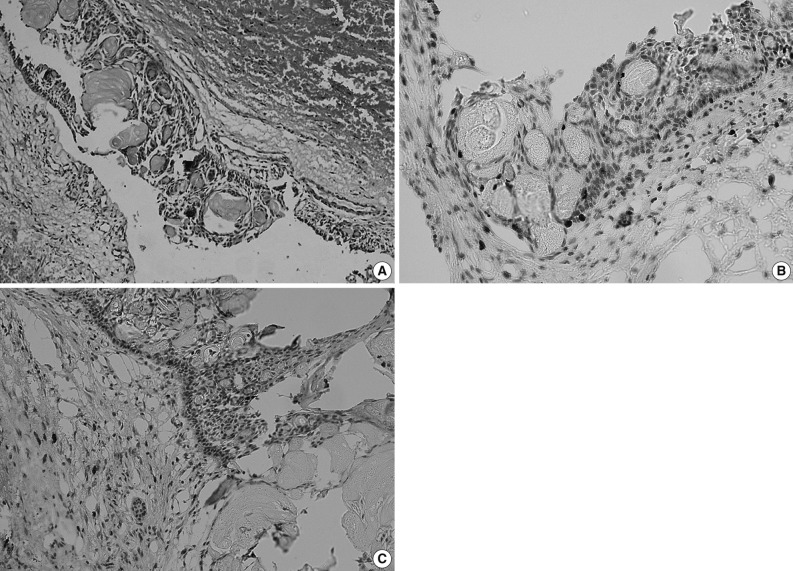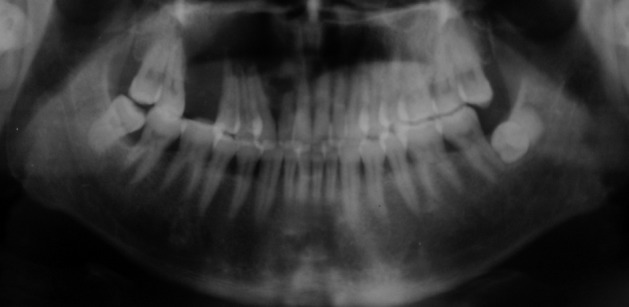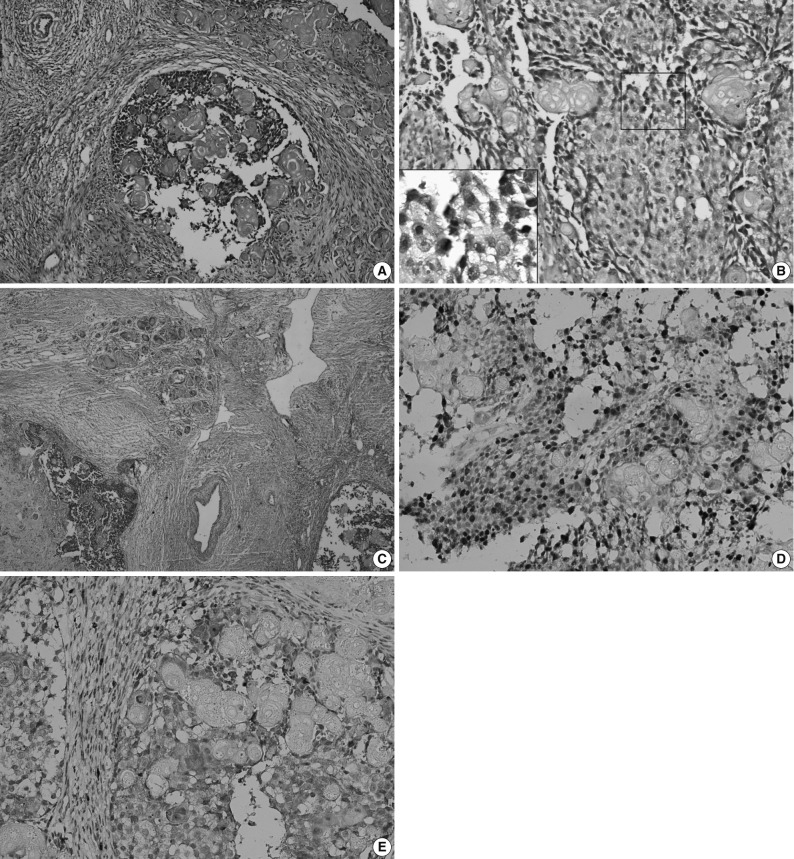Articles
- Page Path
- HOME > J Pathol Transl Med > Volume 46(5); 2012 > Article
-
Case Report
Ghost Cell Odontogenic Carcinoma Arising from Calcifying Cystic Odontogenic Tumor: A Case Report - Zhi-Yu Zhu, Zhi-Gang Chu1, Yu Chen, Wei-Ping Zhang, Di Lv, Ning Geng, Ming-Zhong Yang
-
Korean Journal of Pathology 2012;46(5):478-482.
DOI: https://doi.org/10.4132/KoreanJPathol.2012.46.5.478
Published online: October 25, 2012
Department of Pathology, West China Hospital of Stomatology, Sichuan University, Sichuan, China.
1Department of Radiology, West China Hospital of Stomatology, Sichuan University, Sichuan, China.
- Corresponding Author: Yu Chen, M.D. Department of Pathology, West China Hospital of Stomatology, Sichuan University, Sichuan 610041, China. Tel: +86-28-61153399, Fax: +86-28-61153399, chen_yuhx@163.com
• Received: December 9, 2010 • Revised: November 24, 2011 • Accepted: November 30, 2011
© 2012 The Korean Society of Pathologists/The Korean Society for Cytopathology
This is an Open Access article distributed under the terms of the Creative Commons Attribution Non-Commercial License (http://creativecommons.org/licenses/by-nc/3.0) which permits unrestricted non-commercial use, distribution, and reproduction in any medium, provided the original work is properly cited.
Figure & Data
References
Citations
Citations to this article as recorded by 

- Late recurrence of calcifying odontogenic cyst: Report of a rare case and review of the literature
Paris Tamiolakis, Maria Georgaki, Panagiotis Christopoulos, Nikolaos G. Nikitakis
Oral Surgery.2024; 17(3): 258. CrossRef - Treatment challenges of persistent ghost cell odontogenic carcinoma: a case report and literature review
Ali Al-Sammak, Othman Rezki, Michael Pennington, Frances Manosca, Maria Cuevas-Nunez, Mohammed Qaisi, Even Greenbaum, James Murphy
Oral Surgery, Oral Medicine, Oral Pathology and Oral Radiology.2023; 136(4): e123. CrossRef - Ghost cell odontogenic carcinoma: A rare case report and review of literature
Yong Xia, Zongchang Song, Xinlei Zhang, Xinhong Guan, Guifang Tan, Yi Le, Shuang Liu, Hui Xue, Jing Li, Yajun Zhang, Jing Chen, Huajuan Jiang, Xia Jiang, Yanxia Cheng, Chuchu Zhou, Xu Sha, Jin-Xin Lou
Medicine.2023; 102(38): e35225. CrossRef - A novel parotid carcinoma with a prominent ghost cell population: a masquerading tumor or “salivary ghost cell carcinoma”?
Hiroshi Harada, Mitsuo P. Sato, Naoki Otsuki, Mao Kawamura, Akira Kurose, Takao Satou
Medical Molecular Morphology.2022; 55(1): 76. CrossRef - Dentinogenic ghost cell tumor with focal atypical features suggesting ghost cell odontogenic carcinoma: Report of a challenging diagnosis
Danielle Castex Conde, Gustavo de Souza Vieira, Pâmella de Pinho Montovani, João Pedro Roque Beserra, Mauro César Gaspar Ribeiro, Rafaela Elvira Rozza-de-Menezes, Karin Soares Cunha
Oral Oncology.2022; 124: 105524. CrossRef - Comparative Analysis Between Dentinogenic Ghost Cell Tumor and Ghost Cell Odontogenic Carcinoma: A Systematic Review
Gustavo de Souza Vieira, Pâmella de Pinho Montovani, Rafaela Elvira Rozza-de-Menezes, Karin Soares Gonçalves Cunha, Danielle Castex Conde
Head and Neck Pathology.2021; 15(4): 1265. CrossRef - Ghost cell odontogenic carcinoma of anterior mandible
Gopikrishnan Vijayakumar, Mala Kamboj, Anjali Narwal, Anju Devi
Journal of Oral and Maxillofacial Pathology.2021; 25(Suppl 1): S99. CrossRef - Ghost cell odontogenic carcinoma of the jaws: Report of two cases and a literature review
Meng-Qi Jia, Jun Jia, Li Wang, Hai-Xiao Zou
World Journal of Clinical Cases.2019; 7(3): 357. CrossRef - Ghost cell odontogenic carcinoma with suspected cholesterol granuloma of the maxillary sinus in a patient treated with combined modality therapy
You Qin, Yanwei Lu, Liduan Zheng, Hong Liu
Medicine.2018; 97(7): e9816. CrossRef - A lesion categorized between ghost cell odontogenic carcinoma and dentinogenic ghost cell tumor with CTNNB1 mutation
Yae Ohata, Kou Kayamori, Akane Yukimori, Kanako Sumikura, Toshimitsu Ohsako, Hiroyuki Harada, Kei Sakamoto, Tohru Ikeda
Pathology International.2018; 68(5): 307. CrossRef - A case of large ghost cell odontogenic carcinoma arising in the mandible
Daisuke ARAKI, Shunichi YOSHIDA, Keisuke KOYAMA, Shuutarou ISHII, Toshihiro HASEGAWA, Sadao OOYAMA
Japanese Journal of Oral and Maxillofacial Surgery.2018; 64(12): 708. CrossRef - Three-dimensional volumetric analysis of ghost cell odontogenic carcinoma using 3-D reconstruction software: a case report
João Pedro Perez Gomes, Andre Luiz Ferreira Costa, Carlos Takahiro Chone, Albina Messias de Almeida Milani Altemani, João Maurício Carrasco Altemani, Carmen Silvia Passos Lima
Oral Surgery, Oral Medicine, Oral Pathology and Oral Radiology.2017; 123(5): e170. CrossRef - Ghost cell odontogenic carcinoma transformed from dentinogenic ghost cell tumor of the maxilla after recurrences
Sase Miwako, Itoh Hiroto, Nakano Takahumi, Hayasaka Junichi, Noguchi Tadahide, Jinbu Yoshinori, Mori Yoshiyuki
Journal of Oral and Maxillofacial Surgery, Medicine, and Pathology.2017; 29(5): 438. CrossRef - Ki-67 and p53 expression in ghost cell odontogenic carcinoma: a case report and literature review
G. Del Corso, M. L. Tardio, D. B. Gissi, C. Marchetti, L. Montebugnoli, A. Tarsitano
Oral and Maxillofacial Surgery.2015; 19(1): 85. CrossRef - Integrative genomic analysis of ghost cell odontogenic carcinoma
Pinaki Bose, Erin D. Pleasance, Martin Jones, Yaoqing Shen, Carolyn Ch’ng, Caralyn Reisle, Jacqueline E. Schein, Andrew J. Mungall, Richard Moore, Yussanne Ma, Brandon S. Sheffield, Thomas Thomson, Steven Rasmussen, Tony Ng, Stephen Yip, Christopher W. Le
Oral Oncology.2015; 51(9): e71. CrossRef - Pediatric Metastatic Odontogenic Ghost Cell Carcinoma: A Multimodal Treatment Approach
Safia K. Ahmed, Masayo Watanabe, Daphne E. deMello, Thomas B. Daniels
Rare Tumors.2015; 7(2): 73. CrossRef - Predictive Factors of Potential Malignant Transformation in Recurrent Calcifying Cystic Odontogenic Tumor: Review of the Literature
Sepideh Mokhtari, Zhaleh Mohsenifar, Maedeh Ghorbanpour
Case Reports in Pathology.2013; 2013: 1. CrossRef
Ghost Cell Odontogenic Carcinoma Arising from Calcifying Cystic Odontogenic Tumor: A Case Report



Fig. 1 Calcifying cystic odontogenic tumor. (A) Histopathologic examination shows the epithelial lining is composed of columnar or cubical cells, and the nuclei of which are barrier-ranged. Sporadic or conglobate ghost cells are seen in the lining epithelium. (B) Immunohistochemistry shows the Ki-67 is sparsely expressed in tumor cells but negatively in ghost cells, and (C) matrix metalloprotease-9 (MMP-9) is sparsely expressed in tumor cells and interstitium but negatively in ghost cells (Ki-67 and MMP-9 marker).
Fig. 2 Panoramic X-ray film shows a nonopaque lesion located between the right upper lateral incisor and second premolar. The absorption of the root apex could be detected in the involved teeth.
Fig. 3 Ghost cell odontogenic carcinoma. (A) Histopathologic examination shows epithelial cell nests in tumor tissue. (B) Tumor cells are admixed with anucleate ghost cells. Inset: Several tumor cells show atypical mitoses. (C) The tumor cells invade the surrounding vessel. The tumor cells infiltrate into the adjacent fibro-vascular tissue. The clusters of ghost cells are diffusely distributed in the tumor nests. (D) Immunohistochemistry shows the Ki-67 is strongly expressed in the tumor cells but negatively in ghost cells, and (E) matrix metalloprotease-9 (MMP-9) is strongly expressed in interstitium, weakly in the tumor cells but sparsely in ghost cells (Ki-67 and MMP-9 marker).
Fig. 1
Fig. 2
Fig. 3
Ghost Cell Odontogenic Carcinoma Arising from Calcifying Cystic Odontogenic Tumor: A Case Report

 E-submission
E-submission



 PubReader
PubReader Cite this Article
Cite this Article




